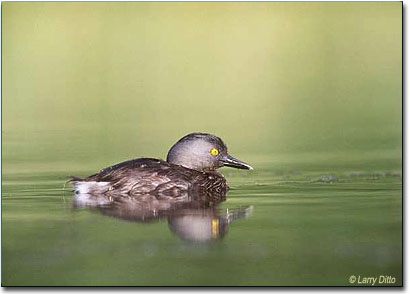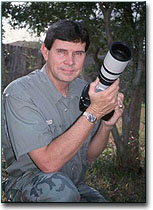Recently, much of my photography has been in and around the water working
subjects like least grebes and black-bellied whistling ducks. These are
common species near my home in south Texas, and are highly prized by
visiting birders and photographers because of their limited U.S.
distribution. Unfortunately, they are difficult to approach except by
water.
 I prefer to keep over-water photography as simple as possible because it's
just too difficult to move a heavy blind and lots of equipment through
dense shoreline cover and into a pond. Murphy's Law says (indirectly) that
the more equipment one carries to the pond, the greater the odds are that
some will get wet. My basic equipment for these outings is limited to a
large inner tube, a short board (shooting platform), a camouflage cover,
monoball, camera, lens and small, water-proof container.
I prefer to keep over-water photography as simple as possible because it's
just too difficult to move a heavy blind and lots of equipment through
dense shoreline cover and into a pond. Murphy's Law says (indirectly) that
the more equipment one carries to the pond, the greater the odds are that
some will get wet. My basic equipment for these outings is limited to a
large inner tube, a short board (shooting platform), a camouflage cover,
monoball, camera, lens and small, water-proof container.
The shot selected for this article was taken from a tube similar to those
used for float fishing, fitted with a 3' x1"x10" board laid across the
tube for a shooting platform. An Arca Swiss monoball was attached to the
board and used to support a Canon 300mm EF lens, Canon 2X teleconverter and
Canon EOS 1-N Camera. Extra film and batteries are about the only extra
items I carry when floating and those ride on the shooting platform in a
plastic container. I don't recommend zip-lock bags since they usually
leak...sealed Tupperware is more certain to keep the contents dry if the
item slips into the drink (and, eventually, it will).
I try to find a secluded spot or well protected cove to get into the tube.
After draping a camouflage cloth (or netting), I'm ready to crawl away from
shore; I use camou-cloth with a shooting port and viewing window sewed in.
Since the material drapes over everything and into the water, the edges
get wet and pretty much hold the cover in place. My arms are locked over
the tube or rest on the shooting platform, and I simply crawl along,
staying in shallow water where I maintain contact with the bottom.
Depending on the position, my knees, feet or backside are always on the
bottom and keep me and tube fairly stable for shooting. For deeper water,
a fishing tube with seat would be more suitable but is much less stable for
shooting.
A slow, indirect and quiet approach will prove successful, especially for
wading birds, turtles, and even mammals that come to water. On the other
hand, ducks, geese, and swans are always sensitive to unnatural objects,
but they can be approached if not otherwise disturbed. Since most
photographers shoot early and late, the birds are more likely to be
preoccupied with feeding and/or tending to their young. Also, the wind is
more likely to be calm at those hours, and still water helps keep the tube
steady. Float tubes work especially well in small, isolated ponds where
wave action is minimal and wildlife is less disturbed.
For most of us, this is a warm weather technique, but simple, inexpensive
and effective. Furthermore, it allows the photographer to capture those
eye-level shots that are so much more appealing that anything taken from a
car window or conventional blind.
 Larry Ditto is well-known in south Texas as a photographer and wildlife
biologist. Larry was the manager of the Santa Ana National Wildlife Refuge
in the Rio Grande Valley for years. His photos have been on the cover of
Texas Parks & Wildlife, Birder's World, Wild Bird and others. Larry
teamed-up with Greg Lasley to win the 2000 Valley Land Fund Photo Contest
and Larry placed in several major categories in past contests. Larry's
photo are marketed by KAC Productions.
Larry Ditto is well-known in south Texas as a photographer and wildlife
biologist. Larry was the manager of the Santa Ana National Wildlife Refuge
in the Rio Grande Valley for years. His photos have been on the cover of
Texas Parks & Wildlife, Birder's World, Wild Bird and others. Larry
teamed-up with Greg Lasley to win the 2000 Valley Land Fund Photo Contest
and Larry placed in several major categories in past contests. Larry's
photo are marketed by KAC Productions.

